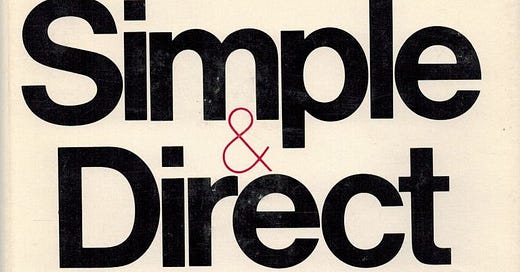Simple & Direct: A Rhetoric for Writers
A classic guide on non-fiction writing, written for the average person by a great teacher and intellect.
Most of my life has been spent reading books on logic, language, and writing. One of my favorite such books is Simple & Direct, by the late Jacques Barzun.
Barzun was a highly respected professor of history at Columbia University who wrote eminent and readable books (over 40 books) on a variety of subjects including teaching and schooling (Teacher in America and Begin Here), intellectual history, French poetry (An Essay on French Verse), and more. Born in France in 1907, he died in 2012 at the age of 104.
(There is more biography of Jacques Barzun at this centennial page, at Wikipedia, and at lectures about and interviews with Barzun on YouTube, just one of which is: Forgotten Thinkers: Jacques Barzun, by Wes Cecil.)
The official publisher’s blurb:
In Simple & Direct, Jacques Barzun, celebrated author and educator, distills from a lifetime of writing and teaching his thoughts about the craft of writing. In chapters on diction, syntax, tone, meaning, composition, and revision, Barzun describes and prescribes the techniques to correct even the most ponderous style. Exercises, model passages — both literary and unorthodox — and hundreds of often amusing examples of usage gone wrong demonstrate the process of making intelligent choices and guide us toward developing strong and distinctive prose.
Table of Contents
I DICTION, or Which Words to Use
II LINKING, or What to Put Next
III TONE AND TUNE, or What Impression Will It Make?
IV MEANING, or What Do I Want to Say?
V COMPOSITION, or How Does It Hang Together?
VI REVISION, or What Have I Actually Said?
VII TO USE OR NOT TO USE
VIII TAKE A LITTLE THOUGHT
It includes exercises, an appendix of hints toward improving sample sentences from the book, and an index of words, topics, and authors.
Why not just rely on more modern books on the subject?
Barzun is a great writer and teacher who always keeps in mind his intended audience: the average person wanting to learn to write well. He doesn’t use academic jargon, and he provides sufficient and interesting examples and exercises to illustrate and fix his points.
He was a champion of intelligence, clarity, and precision in thought and communication from before the disintegrating effects of modern education, the internet, and viral influencers could take their hold. Moreover, however “dated” the book may be (it was first published in 1985, and its latest version may be from 2001) the basic principles of language and communication haven’t changed. Barzun states in his Preface to the Revised Edition:
The reception of this little guide by the public has been so warm and widespread (some readers report reading it mainly for pleasure) that the publisher has summoned me to “bring it up to date.” The chief points, the good advice, are of course permanent; if sound yesterday, they will be tomorrow. But in writing at any time, new confusions and absurdities are cropping up, and it is these — or some of the worst of them — that I have added two chapters about, numbers VII and VIII. These new pages will serve as a guide through contemporary usage and at the same time supply an informal review of the main principles.
Amazon reviews from readers of Simple & Direct:
The only book on writing you need.
When it comes to effective instruction on good writing, there is this book, and all the others. The others may be thrown away. Strunk and White? You must be kidding. Don't waste your time. Buy this book. Study it. Do as it says. You will write 100% better than you do now, and better than many profs.
Read this carefully along with something to put your notes into. This book is a slow burning branding iron. It leaves a lasting impression.
GoodReads.com reviews:
Interestingly, almost all the comments at GoodReads.com are quite bad. Almost no one from that page recommends this book. One lonely dissenting voice, however, said the following:
This book is for adults. Or more accurately, it's not for the capricious. It will not hold your hand, but only instruct; it does not aim to entertain but may do so anyway by virtue of its good sense and clarity of thought. It promotes the idea that one cannot be taught to write well—that is up to each man to learn on his own. It believes that good writing is the product of good thinking, not tricks and hacks. This book encourages each aspiring writer to help himself. For instance, the exercises encountered along the way are not supplied with "solutions," only hints. This will surely annoy the helpless, but the non-jittery reader will appreciate the chance to think for himself.
Those that perceive condescension in the author may not be accustomed to the discomfort of honest instruction. Those dismayed by "outdated" guidelines or expressions, have probably become too accustomed to shallow treatments of difficult subjects.
This is the perfect first book on rhetoric, and if its spirit and ideas are internalized, may prove to be the only such book one ever needs.
I agree.




